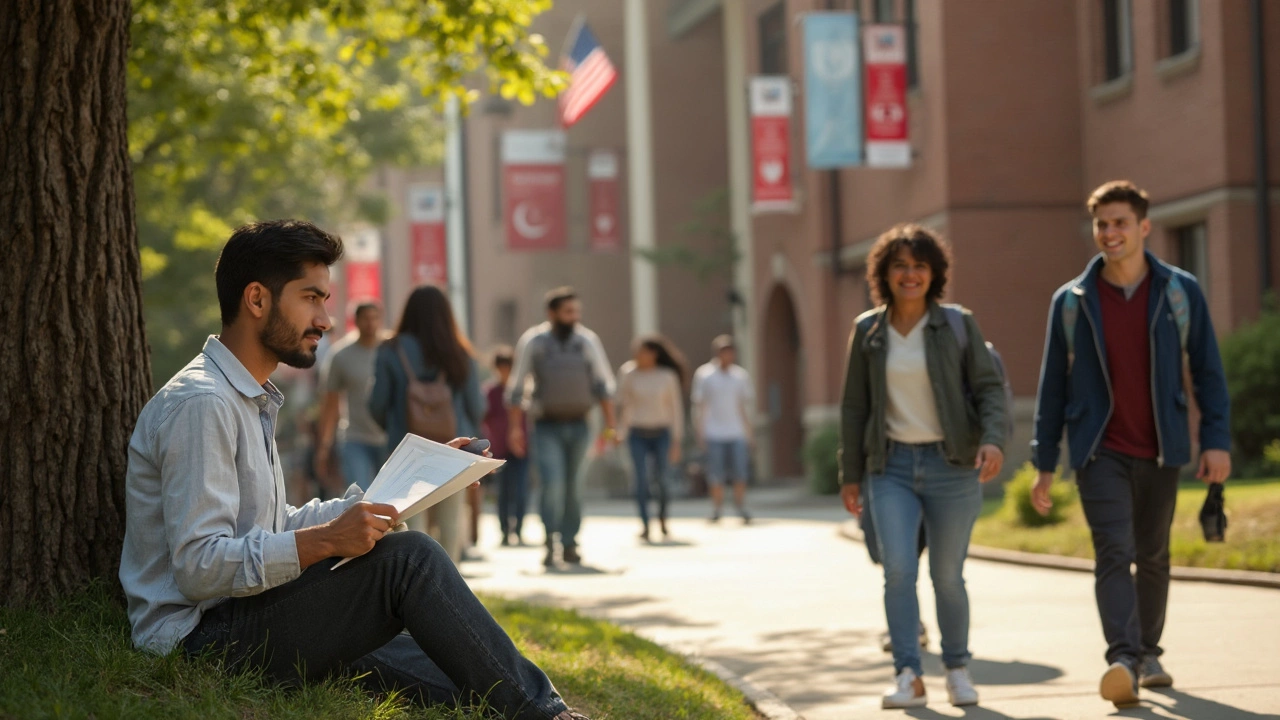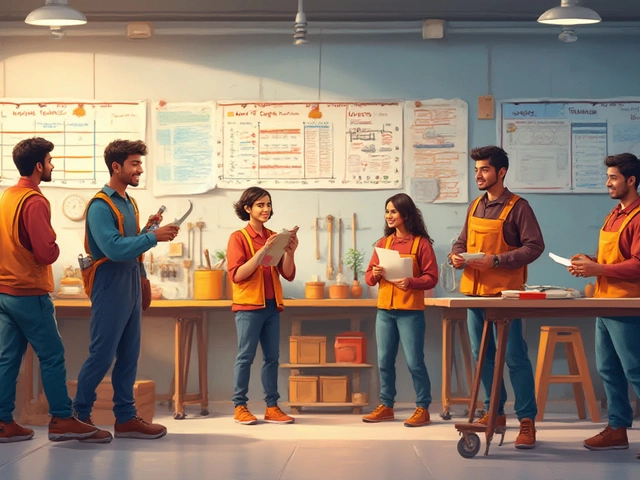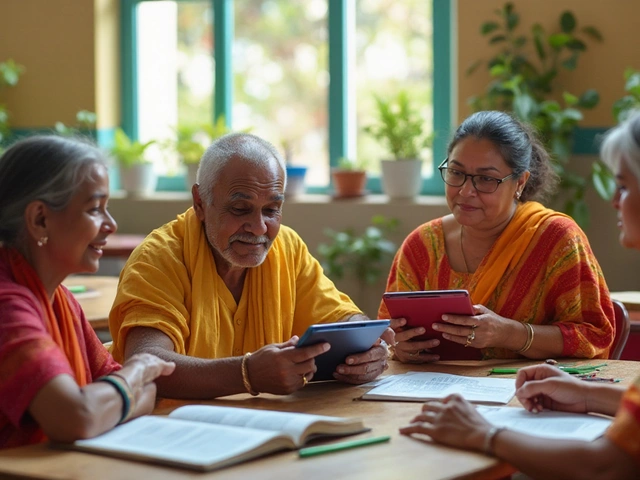Ever wondered if you can just pack your bags and fly to the US for a diploma course? It sounds simple, but the answer isn’t a straight yes or no. In reality, it depends on what you mean by “diploma,” your background, and what the US colleges actually offer to international students.
First off, American colleges usually don’t call their programs “diplomas” the same way we do in India. Most offer “certificates” or “associate degrees,” which line up with our idea of a diploma. So, when searching, you’ll want to look for short-term certificate programs, one-year courses, or technical associate degrees.
The big benefit? Studying in the US can open doors to better job opportunities, a global network, and a once-in-a-lifetime living experience. But here’s the catch: getting in involves more than just filling out an application form. There’s paperwork, visa hoops, and a serious look at your finances.
Don’t get caught guessing—knowing the basics now can save you a ton of headaches later. Let’s talk about what the options really look like, and what you need to actually start your American diploma dream.
- Why Do Indian Students Want Diplomas in the USA?
- Types of Diplomas Offered in America
- Eligibility and Admission: What You Need
- The Visa Process: F-1, Requirements, and Pitfalls
- Cost, Scholarships, and Living in the USA
- Alternatives: Indian Diploma vs American Diploma
Why Do Indian Students Want Diplomas in the USA?
Let’s be real—studying in the USA is still a dream for a ton of Indian students. Why? It’s not just about bragging rights. It’s about high-quality education, global exposure, and the real chance to boost your career options. American colleges have a way of packing practical skills and theory together, so you’ll actually use what you learn in real jobs. Employers worldwide recognize US qualifications, making it easier to stand out when you’re looking for work, especially with a USA diploma attached to your CV.
The US education system is famous for hands-on training, tech-focused campuses, and direct links to the companies that matter. In fields like computer science, business, and engineering, diplomas (usually called certificates or associate degrees there) often lead to internships and entry-level jobs with top firms. Plus, American classes tend to focus less on rote learning—there’s a lot more discussion, problem-solving, and group projects. That’s a totally different style from what Indian colleges usually do.
Check out how many Indian students went to study in the US, and you’ll see why it’s such a buzz:
| Year | No. of Indian Students in the USA |
|---|---|
| 2019-2020 | 193,124 |
| 2022-2023 | 268,923 |
Among these, a chunk jump straight into programs that offer job-ready skills, not just theory-heavy degrees. Fields like health care, data analytics, hospitality, and design are popular since they have fast, skill-based certifications that can be finished quicker than a full four-year degree.
It’s not just about jobs either—living in the US helps you pick up soft skills. Stuff like critical thinking, public speaking, and networking with people from all over the world. And yes, let’s be honest, a US student visa can open doors to future migration or maybe even a longer stay if you hit the right work opportunities after your studies.
Add all this up and you get why so many Indian students are tempted to skip the crowd back home and take their shot at a US diploma.
Types of Diplomas Offered in America
So, what kind of diplomas can you actually get in the US? The thing is, most American schools don’t use the word “diploma” for post-12th grade programs the way we do in India. Instead, you’ll hear about certificate programs, associate degrees, and technical training. Let’s break these down so you’re clear on what matches your goals.
- Certificate Programs: These are short-term courses, usually less than a year, in fields like business, IT, hospitality, or even digital marketing. They focus on hands-on skills and are offered by community colleges or some universities. Good if you want to build a new skill fast.
- Associate Degrees: Lasting about two years, these are offered by community colleges. Think of them as the US version of a diploma after 12th—only broader, with some general education, not just technical stuff. After this, you can often transfer into a bachelor’s degree if you want.
- Postgraduate Certificates: For those who already have a university degree, these are specialized short programs (often a few months to a year). Great if you want to upskill in a particular area—maybe project management or data analysis.
- Technical Diplomas (Vocational): More hands-on and career-focused, these are offered at technical schools. They’re common in automotive tech, culinary arts, or medical assisting. The programs run from a few months up to two years.
But here’s where it gets tricky: Most US universities don’t admit international students into very short (under 1 year) non-degree courses because these don’t qualify for the F-1 student visa. The USA diploma experience you’re likely imagining is usually through longer programs like associate degrees or technical diplomas.
| Type | Duration | Visa Eligible? | Examples |
|---|---|---|---|
| Certificate Program | 4-12 months | Rarely | Digital Marketing, Hospitality, IT Support |
| Associate Degree | 2 years | Yes | Business, Computer Science, Nursing |
| Postgrad Certificate | 6-12 months | Sometimes | Project Management, Data Analytics |
| Technical Diploma | 6-24 months | Usually | Automotive Tech, Culinary Arts, Welding |
If you’re thinking of heading to the States, make sure you look for programs lasting at least 9 months to qualify for a student visa. Always double-check with the college about international student rules for short courses—they can be stricter than you’d expect.
Eligibility and Admission: What You Need
Here’s where it gets real: American colleges have their own rules for who can join their programs, especially if you’re coming from India and aiming for a USA diploma. Most US community colleges and technical schools are open to international students, but you have to follow the steps exactly or you’ll get stuck.
You’ll usually need at least a 12th-grade (higher secondary) certificate from an Indian school. Some colleges might accept 10th-grade for vocational programs but always check on their official website—don’t trust random forums or secondhand info here.
Be ready to show proof of English skills. For nearly every course, you’ll need a solid TOEFL or IELTS score. The cut-off varies, but most two-year colleges look for around 61 on the TOEFL iBT or a 6.0 on the IELTS. Not sure? Email the admissions office and get it straight from them. Some places might even let you in with ‘conditional admission’ if you agree to take extra English classes.
Here’s a basic list of what you’ll need for the application:
- Filled-in application form and fee (usually $50–$100)
- Transcripts or mark sheets from your last school year
- English test scores (TOEFL, IELTS, or sometimes Duolingo English Test)
- Passport copy – yes, make sure it’s valid for at least a year
- Proof you can pay for a year (like bank statements or a sponsor letter)
Some programs (like design or IT) want portfolios or coding samples. Others might want reference letters. It’s not one-size-fits-all, so double-check exactly what’s needed for your program. Deadlines are strict—fall intake apps usually close by March or April, and spring intake by October. Start early!

The Visa Process: F-1, Requirements, and Pitfalls
If you’re eyeing a USA diploma, you’ll need to get familiar with the F-1 visa. This is the official student visa for most academic and certificate courses in the US, including those short-term programs international students often look for.
So, what do you actually need for an F-1 visa? Here’s the main stuff:
- You need to get accepted by a US school or college that’s approved by SEVP (Student and Exchange Visitor Program). Most legit colleges are on that list, but double-check before applying.
- Once you’re accepted, the school sends you an I-20 form. This form is your golden ticket. No I-20, no visa.
- Next, you fill out the DS-160 form online and pay the SEVIS fee. Keep every receipt and confirmation—you’ll need them for the visa interview.
- Then you schedule your visa interview at the US Embassy or Consulate in your area. Slots can fill up fast after exam results, especially in metro cities like Mumbai and Delhi.
For the interview, you’ll need to show:
- Your passport (valid for at least six months after your date of entry)
- Your I-20 and SEVIS payment confirmation
- Proof that you have enough money to pay for tuition, living expenses, and travel (bank statements, loan letters, sponsorship proof, etc.)
- Academic documents (marksheets, certificates, etc.)
- Ties to India, like family, a job offer, or property—something to show you’re coming back after your course ends
Now, the pitfalls. Folks get tripped up by a few common mistakes:
- If your program is too short or isn’t full-time, you may not get approved. The F-1 is strict about full-time study.
- If your funding or documents look weak, visa officers can reject you. They want to be super clear you’re not planning to disappear into the US job market illegally.
- Be honest at your interview. Any fake answers or confusing details can mean an automatic denial.
- Pay close attention to every deadline—visa dates, deposit payments, interview scheduling. Slipping up could cost you a semester.
One last tip—join online student forums or alumni networks at your target college. Lots of Indian students share their visa experience and hacks that you won’t find on official US government pages. It’s sometimes the small details that make or break your application.
Cost, Scholarships, and Living in the USA
When you think about heading to the US for a USA diploma or certificate course, the first shock is usually the price tag. Tuition for community colleges, where most short-term courses are, sits between $6,000 and $12,000 USD per year. If you go to a private college or a bigger city, it can even go up to $20,000 or higher. And that’s just classes—add living, food, transport, health insurance, and you’re staring at a much bigger amount.
| Expense | Estimated Cost (per year) |
|---|---|
| Tuition (community college) | $6,000 - $12,000 |
| Accommodation | $7,000 - $12,000 |
| Food | $3,000 - $4,500 |
| Health Insurance | $1,200 - $2,400 |
| Books & Supplies | $800 - $1,500 |
| Transport/Other | $2,000 - $3,000 |
Not everyone pays full price, though. Loads of colleges have scholarships, but they’re usually merit-based and pretty competitive. Most short-term (one-year) diploma or certificate programs offer fewer scholarships than full degree programs, but don’t give up—some states and colleges have special grants for international students. Look up schools with “international student scholarships” on their official sites and be ready to apply early.
If money is tight, you can save by sharing an apartment with roommates, cooking at home, and using student discounts on travel. Also, some student visas let you work up to 20 hours per week on campus. Don’t expect big pay, but it helps with your expenses. Just remember, off-campus work isn't allowed unless you meet strict conditions later in your course.
Living in America isn’t all Hollywood glamour. Small college towns are usually cheaper. Big cities like New York, Los Angeles, or San Francisco have very high rent and living costs. For example, New York rent can swallow $1,500 a month, but in a smaller town, you’ll pay half of that, and daily expenses drop too.
A pro tip: Before you even apply, make sure you can show “proof of funds.” US colleges and embassies ask for bank statements that prove you can actually pay for your course and living expenses. Skipping this step leads to outright visa rejection, no matter how good your grades are.
Alternatives: Indian Diploma vs American Diploma
Trying to decide between doing a diploma in India or heading to the US? Here’s what you need to know—no fluff, just clear facts.
First off, diplomas in India are usually offered by polytechnic institutes or state-approved colleges. These focus on technical fields like engineering, computer applications, and hospitality. You can finish one in 1-3 years, and it’s often much more affordable. American colleges, on the other hand, usually give out something called a “certificate” or “associate degree.” While the US versions can get you exposure to better resources and a global alumni network, they are way more expensive.
- USA diploma programs (think associate degrees or certificates) tend to be linked directly to the job market. There’s more hands-on tech, practical training, and soft skills development. That can make it easier if you want to find a job or do part-time work during your course.
- Indian diplomas focus more on core technical skills and local industry needs. If you plan to work in India or are on a tight budget, this makes sense.
- The recognition and value of a US diploma or associate degree is higher with international employers, especially if you want to settle abroad. But you'll have to shell out for tuition, visas, health insurance, living expenses, and flights.
Here’s a quick side-by-side comparison to make things easier:
| Indian Diploma | USA Diploma/Certificate/Associate Degree | |
|---|---|---|
| Duration | 1-3 years | 1-2 years |
| Typical Cost (Tuition Only, INR) | 30,000 - 2,00,000/year | 8,00,000 - 18,00,000/year |
| Main Areas | Engineering, IT, Hospitality | Business, Health Sciences, Computing, Culinary |
| Entry Requirement | 10th/12th pass | 12th pass, English tests (TOEFL/IELTS), sometimes SAT/ACT |
| Career Outcomes | Entry-level jobs in India | Option to work/stay in US (OPT), global jobs |
| Recognition | Indian Employers | Global Employers |
There’s no “best” option—just what fits your situation. If you want a shot at international work and can handle the upfront cost, the US route can work. If you want to enter the workforce quickly in India and avoid debt, sticking local makes sense.
One tip: if budget’s an issue but you want global value, look into “dual diploma” or “twinning” programs. Some Indian colleges partner with US ones, so you study part of your course here and finish it in America. Cheaper, and you get the best of both worlds.




